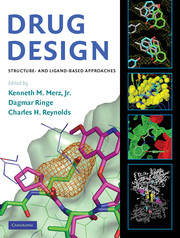Book contents
- Frontmatter
- Contents
- Contributors
- Preface
- DRUG DESIGN
- 1 Progress and issues for computationally guided lead discovery and optimization
- PART I STRUCTURAL BIOLOGY
- PART II COMPUTATIONAL CHEMISTRY METHODOLOGY
- PART III APPLICATIONS TO DRUG DISCOVERY
- 12 Computer-aided drug design: a practical guide to protein-structure-based modeling
- 13 Structure-based drug design case study: p38
- 14 Structure-based design of novel P2-P4 macrocyclic inhibitors of hepatitis C NS3/4A protease
- 15 Purine nucleoside phosphorylases as targets for transition-state analog design
- 16 GPCR 3D modeling
- 17 Structure-based design of potent glycogen phosphorylase inhibitors
- Index
- References
13 - Structure-based drug design case study: p38
from PART III - APPLICATIONS TO DRUG DISCOVERY
Published online by Cambridge University Press: 06 July 2010
- Frontmatter
- Contents
- Contributors
- Preface
- DRUG DESIGN
- 1 Progress and issues for computationally guided lead discovery and optimization
- PART I STRUCTURAL BIOLOGY
- PART II COMPUTATIONAL CHEMISTRY METHODOLOGY
- PART III APPLICATIONS TO DRUG DISCOVERY
- 12 Computer-aided drug design: a practical guide to protein-structure-based modeling
- 13 Structure-based drug design case study: p38
- 14 Structure-based design of novel P2-P4 macrocyclic inhibitors of hepatitis C NS3/4A protease
- 15 Purine nucleoside phosphorylases as targets for transition-state analog design
- 16 GPCR 3D modeling
- 17 Structure-based design of potent glycogen phosphorylase inhibitors
- Index
- References
Summary
INTRODUCTION
The overproduction of cytokines has been implicated in a wide variety of inflammatory diseases such as rheumatoid arthritis, inflammatory bowel disease, psoriasis, multiple sclerosis, osteoporosis, Alzheimer's disease, and congestive heart failure. The ability of p38 mitogen-activated protein kinase (p38 MAPK) to regulate the release and activity of multiple pro-inflammatory cytokines has attracted the interest of numerous pharmaceutical companies and independent researchers during the past decade or so. Since its initial discovery in 1994 as a potential molecular target for a novel class of cytokine suppressive inhibitors (SB-203580), more than 150 patent applications from at least thirty pharmaceutical companies have been published, all claiming novel p38 inhibitors. Four distinct isoforms of p38 MAPK are known: p38α and p38β are widely expressed in eukaryotic cells, including endothelial and inflammatory cells; p38γ is found in skeletal muscle; and p38δ is predominantly found in the small intestine, kidneys, and lung tissue. Of these four isoforms, p38α has been the most studied and is believed to be the most physiologically relevant. Numerous reviews have been published that focus on both the biology and chemistry of p38 inhibitors. The focus of this chapter is an illustration of p38 inhibitor design guided by structural information obtained both from modeling and actual x-ray crystallographic data. Structure references with a “.pdb” suffix refer to those obtained from the Research Collaboratory for Structural Bioinformatics.
- Type
- Chapter
- Information
- Drug DesignStructure- and Ligand-Based Approaches, pp. 197 - 208Publisher: Cambridge University PressPrint publication year: 2010



